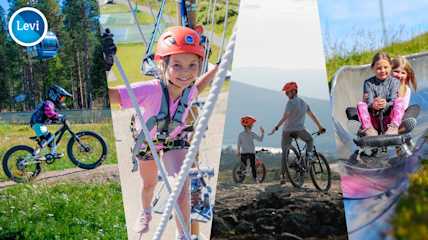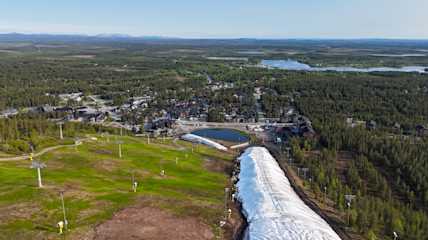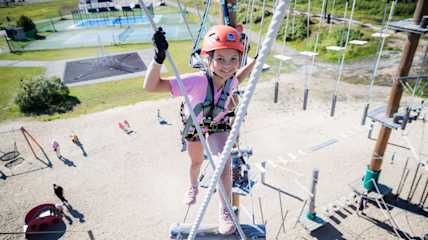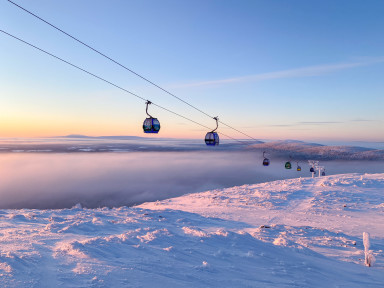
Safety First: How Levi Ski Resort ensures the smooth operation of its Gondola lifts
In this article, we delve into how Levi Ski Resort monitors weather conditions, maintains its lift equipment, and trains its staff. These measures ensure that every holidaymaker can safely and confidently enjoy the breathtaking Fell-Lapland scenery while traveling on the Gondola lifts.
Levi's Gondola Lifts: Scenic Views and Elevation Since 2000
Levi, chosen as the 2023 Ski Resort of the Year, is renowned for its excellent slopes and modern lifts. Among Levi's 26 lifts, two stand out. These are not just lifts; they are windowed "flying rooms" that offer passengers breathtaking views of Levi's enchanting landscapes.
Gondola 2000, as the name suggests, was build in 2000. It was a significant addition to Levi's offerings, not only being the first gondola lift in Levi but also an icon that transports visitors straight to the top of Levi. This lift alone can carry an incredible 3,000 people per hour. In 2007, as Levi had already established itself as a top destination in the Nordics, another gondola lift named Express Gondola was opened for Front Slopes.

Why might a Gondola lift be closed?
The operation of a gondola lift is influenced by various factors, which can be technical, environmental, or safety related. For instance, strong winds and wind direction can make the use of the gondola lift unsafe, leading to its closure.
- If the wind is blowing parallel to the lift line, it's not as bad as a crosswind. The wind's direction determines when the lift is closed. If the wind speed exceeds 15 m/s from the wrong direction, meaning crosswind, the lift is closed. Wind conditions are constantly monitored, and the lift is closed as needed, explains Teemu Hämäläinen, the slope manager of Levi Ski Resort.
It can often happen that there is no wind in the village below, but higher up in the fell, the wind is stronger, leading to the closure of the lifts. If it's extremely windy, all gondola cabins are collected.
In winter, extreme cold can also lead to lift closures, with a cold limit of -25°C. Inversions can affect temperatures in the fells, causing warmer air to remain higher above the ground. This occurs because the temperature increases as you go higher, and fell peaks are at higher elevations. In inversion situations, warmer air may stay at the top of the fell, resulting in cooler and colder weather lower down the slopes.
- The temperature might be -25°C at the lower station and -5°C at the upper station. In such cases, we monitor the temperature development and wind, but if it's -25°C at the upper station, the lifts are closed. This is because if the lift stops for any reason and we must evacuate passengers from the gondola, it's extremely cold for customers to wait for the rope rescue team to arrive and lower them down, explains Hämäläinen.
During summer and fall, lightning near the gondola lift can be dangerous, leading to lift closures. In the summer of 2023, lightning caused significant damage to the Gondola 2000 lift.
- We monitor the weather, and if thunderstorms start, we close the lift. Thunderstorms can also bring storms and strong winds. It takes about half an hour to stop Gondola 2000 and store the gondola cabins if necessary. If the weather front looks like it's passing by, we leave the cabins but install lightning conductors, also known as grounding wires, says Teemu Hämäläinen.
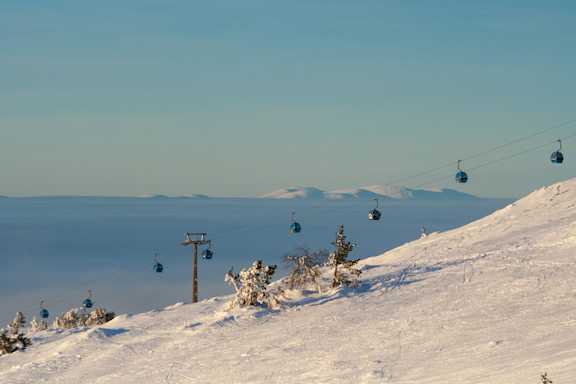
Accumulation of snow and ice on the cables or other mechanical parts can disrupt lift operations.
- This is a problem early in the season, such as during the Levi World Cup time. If the temperature is around freezing, and it's drizzling, the water can cling to the cables. If the temperature drops a degree or two below freezing, it comes off. Lift manufacturers couldn't believe that it wouldn't come off the cables, and they came to see it for themselves. After that, we installed a device that shoots an anti-icing substance into the cable. This may be done a couple of times a day. It has to be anticipated by monitoring weather reports, explains Hämäläinen.
Temporary power outages can cause momentary interruptions in gondola lift operation.
- They are not long outages. It takes some time when the lift stops, and the system starts running again, says Hämäläinen.
Modern gondola lifts use software for control and monitoring. Software errors can lead to problems. However, Levi's lifts have only experienced brief disruptions due to this.
- There is a direct connection from the factory to the lifts, and they can access the systems directly. From the factory, they can see where the problem is and possibly fix it remotely, says Teemu Hämäläinen.
If there is a safety issue with the lift, its use may be interrupted until the problem is resolved.
- For example, if a customer enters the lift cabin too late, and something gets caught in the door, the lift stops. The lift has safety devices that constantly monitor various functions. If the problem is not immediately found, there is a backup diesel engine. It is switched on, and it drives the lift line empty. This bypasses the problem, and all cabins can be driven to the stations, says Hämäläinen.
The backup diesel engine is used when the problem is not immediately identified so that the lift can be set in motion. The engine, located outdoors, is used every morning, and once a month, the lift is operated with the backup system. This allows checking its operation, and lift staff practice using it. The same procedure is carried out with every lift at Levi.
During winter, hoarfrost accumulating on trees may require action.
- In winter, we monitor the trees as hoarfrost begins to accumulate on them. The danger is that a tree may fall onto the lift line. Every morning, snowmobiles ride through the lift lines and assess the situation. If necessary, we try to remove hoarfrost from the trees or fell the tree. Hoarfrost accumulates during the winter, and snowmaking also collects snow on the trees, says Teemu Hämäläinen.
All these and many other factors are constantly monitored to ensure the safe and efficient operation of the gondola lifts.
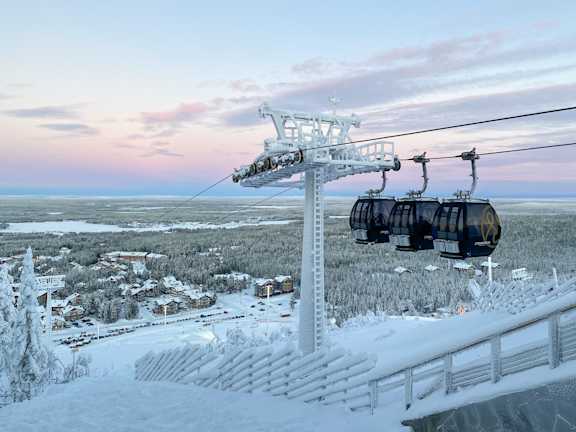
Skills and Readiness - Levi's Rope Rescue Team
If a lift cannot be set in motion, even with the help of a backup, i.e., a diesel engine, and there are passengers in the gondola cabins, specially trained rope rescuers are employed. They descend into the gondola and evacuate passengers one by one using descent equipment.
- In such cases, we first notify the emergency center. After that, Levi Ski Resort's own rope rescue team is called to the scene. If this happens in winter, the team goes to the site by snowmobile and climbs up the lift pole. A rope rescuer then starts moving towards the gondola cabin using the cable and descends onto its roof. After that, the customers are lowered to the ground using descent equipment. We also have a crane with a 16-meter-long boom at our disposal, which can be used to lower customers in chairlifts and gondola lifts, says Teemu Hämäläinen.
Levi has never had to lower customers from lifts using the rope rescue team. The rope rescue team practices rescue operations twice a year, and the fire department practices with its own team at Levi once a year. Levi's crane can also be sent to Ylläs for assistance if needed, or a crane from Ylläs can come to Levi as required.
Rescue operations are subject to regulations and standards that specify how the rescue operations for gondola lifts should be carried out and the kind of training the rescue personnel should have.
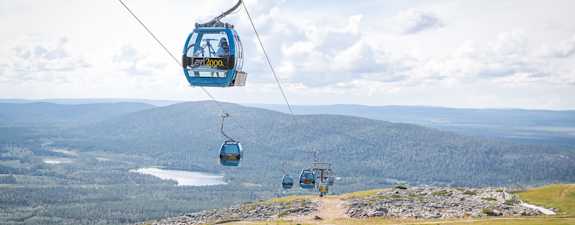
Regular maintenance and inspection of gondola lifts are required to ensure their safety and efficiency
Daily Checks: Every day, before starting operation, lift operators perform prescribed morning checks. If any irregularities are found, they are reported to the lift maintenance, which comes to fix the issue.
Monthly lift maintenance: In this maintenance, upper and lower stations are thoroughly inspected, lift poles are checked, and their rollers are examined. The passage of the cables is also checked; they should pass through the rollers' center. Bearings, bolts, and other parts are inspected as well.
Annual inspection is carried out through an inspection authority. In Levi, the inspection is conducted by Kiwa, one of the world's largest testing, inspection, and certification companies.
Part Replacement: Guidelines from manufacturers specify the allowable wear for all wearing parts.
- The bearings in the deflection wheels have a number of operating hours, which is 20,000. After this, they need closer monitoring or replacement. When this happens, the factory installer comes to Levi to guide how they should be replaced. Since Gondola 2000 was put into operation, the bearings in the deflection wheels have been replaced twice. They are located at the upper and lower stations, and there are four in total. Every four years, the cables are run through a measuring device to check for broken individual strands, for example. Every four years, the anchor pipes for the foundations are also inspected, says Hämäläinen.
Major maintenance of the lifts is carried out during the summer when the lifts are not in operation. In addition to all these maintenance measures, safety protocols and training are crucial for the efficient and safe operation of gondola lifts. The lift staff is trained to identify potential issues and rectify them properly.

